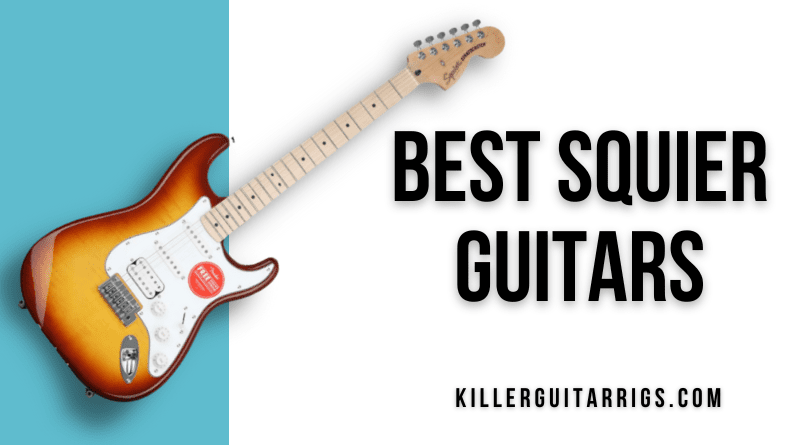Squier is one of the world’s best-selling guitar brands. They are a subsidiary of Fender and have been part of the Fender Musical Instrument Corporation since 1965. They were previously a string manufacturer, but when Fender needed a brand name to use for their budget import models, they repurposed the Squier name.
The quality of Squier guitars has historically been quite unreliable, but things have really changed over the years. No matter which Squier you buy, you’re almost certain to get a high-quality instrument that sounds great. With each passing year, they add more models to their portfolio and, simultaneously, the quality keeps on getting better.
With all that in mind, we put together this KillerGuitarRigs Review to highlight the 7 Best Squier Guitars for sale today. When reviewing, we were looking mostly at build-quality and tones, 2 areas that have historically plagued this style of affordable guitar.
Keep on reading to learn more about these great guitars.
Read more about our review process.
Our Top 3
Our Top Pick was the Squier Affinity Series HSS Stratocaster. This Strat has one of the nicest finishes ever applied to a Squier, and offers a huge range of tones thanks to its dynamic HSS pickup configuration.
Budget-conscious shoppers should check out our Best Budget model, the Squier Bullet Mustang. This is a raucous punk icon with exceptional playability and killer tones at an incredibly low price.
If you’re looking for the best Squier on the market, you really need to consider our Editor’s Choice, the Squier 40th-Anniversary Gold Edition Jazzmaster. This JM is built with the working musician in mind, meaning it’s stage- and studio-ready, and still costs way less than its nearest Fender equivalent.
Individual Reviews
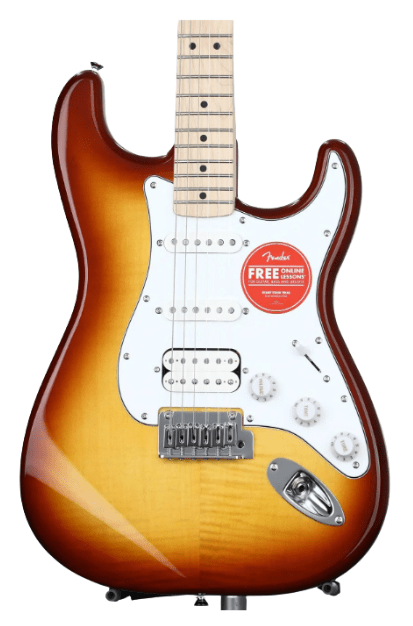
Squier Affinity Series HSS Stratocaster
A versatile and dynamic Stratocaster that suits a broad range of music styles.
This is a fantastic guitar for players looking to learn guitar, but who might not have settled on a particular style. Having access to both humbucking and single coil tones opens up this guitar to practically any genre, and the timeless styling and robust build quality further add to the appeal.
This Squier Affinity Series HSS Stratocaster was a real joy to play (full review here). The Affinity line has improved leaps and bounds in recent years, and their current lineup, this guitar among them, offers excellent playability and great tones.
Our test model came to us in a stunning Sienna Sunburst finish, with a fantastic flamed-maple top. The bulk of the body was made with poplar, resulting in a relatively lightweight, yet sturdy instrument.
It had a maple neck, complete with a maple fretboard. The neck was un-tinted, and left in a very natural, light color, which suited the Sienna Sunburst finish well. Not only did it look good, it felt good. It had a C-shape profile, which felt substantial in the hand. It wasn’t as slim as a lot of beginner instruments, but we didn’t feel it would be uncomfortable for new players at all.
Fit and finish on the whole instrument were another big surprise. Bullet- and Affinity-series guitars in the past were notorious for sharp and uneven frets, but we found no such thing here. The frets were well-leveled and had nicely rounded edges.
It had a HSS pickup configuration, with a humbucker in the bridge and single coils in the middle and in the neck. The pickups were pretty hot, although they stayed clear and delivered proper chimey Strat tones without ever sounding too thin. The Humbucker gave us nice, fat lead tones, particularly when pushed with some overdrive.
We found it to be well set up out of the box, which is ideal for the target market. It’s ready to play as soon as you tune up and plug in, and it offered a nice medium string height. Tuning stability was strong and the tuners were surprisingly good, with no excessive play, wobble, or slippage.
Verdict: The Squier Affinity Series HSS Stratocaster is a superb beginner’s guitar. It has everything you need to learn the fundamentals and then some. It’s affordable, and it looks absolutely fantastic, especially with the flamed-maple top, which is a first for any Squier.
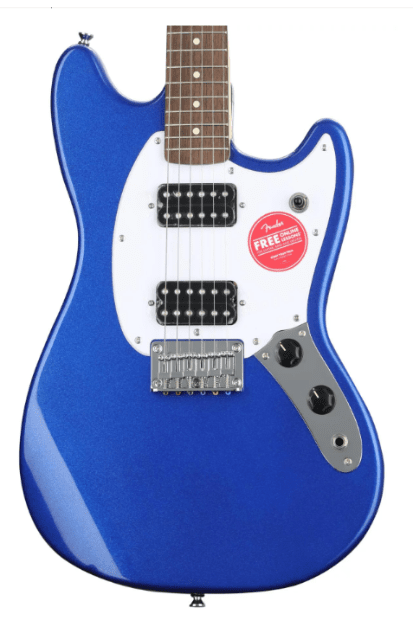
Squier Bullet Mustang
Fender’s original student grade instrument stripped back and ready to rock.
If you’re looking to avoid spending too much, but you still want a good looking Squier with great tone and tons of attitude, this is the guitar for you. It’s one of the most affordable models in the line up, and yes, it still lives up to the quality expected of the brand.
The Squier Bullet Mustang is a low-cost version of Fender’s punk icon (read our full review). Its asymmetrical design combined with hard-hitting pickups made the original extremely popular during the punk movement. Now you can have your own little piece of that history.
The guitar we received for this roundup came in a super-cool Imperial Blue finish, which had an almost glittery look. It was definitely striking, but if you like your guitar a bit more subdued, it also comes in Black, and Sonic Grey.
Its body, like almost all other Squier models, was made with poplar, but the Mustang was noticeably lighter, most likely because it has an ultra-slim body.
It had the same C profile neck as our top pick, the Affinity Stratocaster, which was chunkier than expected. Despite being a little fuller than the average beginner neck, it was still comfortable and caused no issues with reaching the frets, or fatigue with extended use.
We found that the quality of the fretwork was excellent, considering the low cost of the guitar. At a minimum, we ask that a guitar not have any sharp edges and that its frets come well-leveled with no dead spots. The Mustang delivered both. The fretboard was made with Indian laurel and, once again, we found ourselves pleasantly surprised, especially as we’ve encountered some poor laurel fretboards in the past.
The humbuckers delivered big, punchy tones with great responsiveness and genuinely dynamic range. They were able to give us some nice cleans, but they really performed best with high gain, pushing the amp into a lush, full overdrive.
Verdict: The Squier Bullet Mustang is much more than an entry-level guitar. It represents the spirit of the original insomuch as it is a good-looking, simple-to-use guitar with excellent playability and great tones, all at an absolute bargain price.
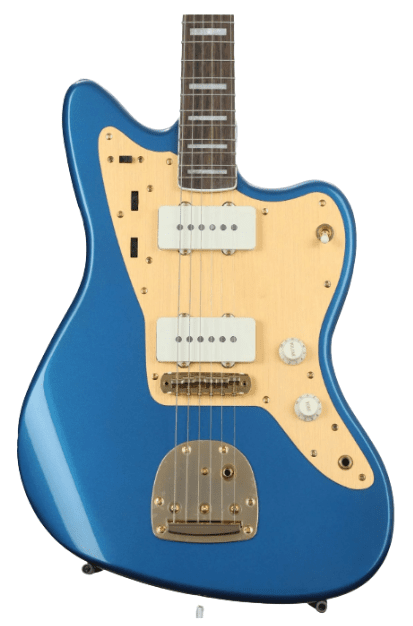
Squier 40th Anniversary Gold Edition Jazzmaster
Fender tones and build quality at a fraction of the price.
With this guitar you’re getting a working musician’s grade instrument at intermediate prices. It’s made with superior components, and the quality control is a cut above that found on the average Squier.
Squier’s range of premium models is continuing to expand, and the Squier 40th-Anniversary Gold Edition Jazzmaster might just be the best guitar the budget brand has ever made (check out our full review).
The Jazzmaster is known for its striking offset looks, and this Squier really nails the aesthetic. It had gold hardware and a gold anodized bridge, giving it a look similar to the J Mascis special edition which has been such a runaway success. The test model came to us in Olympic White, and it was genuinely one of the prettiest guitars we’ve had the chance to review in some time.
It was made from poplar, which is extremely common on Squier guitars. This was one of the heaviest models in the roundup, but that was likely due to the overall size of the guitar. If you’re not used to Jazzmasters, you’ll notice right away that they are large guitars.
It had a full C-shape neck, which we’ve found on several other models in this review, but the key difference with the Jazzmaster was the neck finish. It had a semi-gloss coating and felt far superior to the almost unfinished feel of the entry-level models.
The Indian laurel fretboard was easily the nicest of any of the guitars on test. It was clearly a better cut of wood and was better hydrated, giving it a much smoother feel and a richer look. The fretboard edges had a nice cream binding, and the fretwork was excellent.
Some players often mistake the Jazzmaster’s pickups as P90s, but they are in fact just regular single-coils, albeit in a different housing. In the lead circuit, tones were exceptionally bright and clear. With the rhythm circuit active, tones were noticeably richer and more mellow.
Verdict: The Squier 40th-Anniversary Gold Edition Jazzmaster is a rare beauty in this price range. It does cost quite a bit more than your average Squier, but the tones and build quality are closer to what you’d find on a Fender rather than other Squier models.
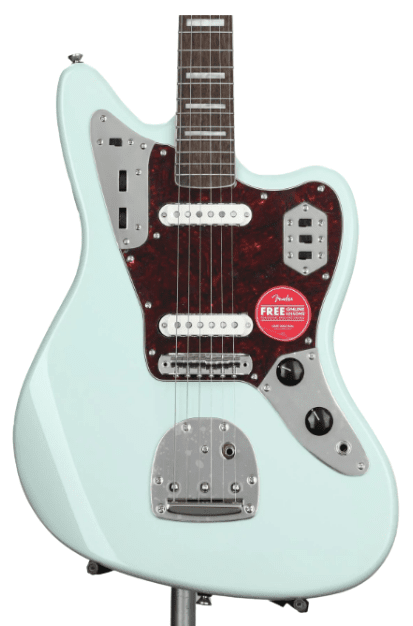
Squier Classic Vibe ‘70s Jaguar
From surf rock to grunge, the Jaguar is a guitar that can do it all.
This guitar offers so many tonal varieties that it really could be the only guitar you’ll ever need. It has fantastic offset styling, and as it’s part of the Classic Vibe Series, it gets premium appointments like alnico pickups and a genuine bone nut.
The Jaguar is yet another Fender guitar that went on to become a pop culture icon in its own right. It was most famously used by Kurt Cobain in the Nevermind era and, despite not being his only guitar, is now the model most closely associated with him. Now with this Squier Classic Vibe ‘70s Jaguar, you can have your very own at a fraction of the price.
We were pleased that our test model had our favorite finish – Surf Green. The Black, and the Sunburst options look great in their own right, but the combination of Green and the Tortoiseshell pickguard is such an iconic look. Squier really nailed it with the quality of the finish on this Jag.
The neck, like all the guitars on test, had a C shape, which by this point we were quite used to. Fortunately, the Jag had the same high-quality finish on its neck as the 40th-Anniversary Jazzmaster, making it an absolute joy to play.
We found the pickups to be a particular strong point on this Jaguar. They were Fender-designed alnico single coils, and they performed impeccably across almost every metric. They gave us sharp, clear cleans and when we wanted break up, we got dirty, grimy, rowdy grunge tones that made us wish these Squiers were available in the ’90s!
Our only real gripe with the Jaguar was the trem system, specifically the arm. Jags and Jazzmasters don’t have a screw-in tremolo arm like Strats. Instead it just slots in. On the Squier, we found that it fell out far too easily, making it difficult to use in the real world.
Verdict: The Squier Classic Vibe ’70s Jaguar is one of the best-looking models in the entire Squier lineup. It offers authentic Fender feel and playability, and delivers hard-hitting tones across pretty much any genre of music.

Squier Contemporary Telecaster
Punishing metal tones and Telecasters haven’t traditionally gone together – until now.
If you love the Telecaster body style but you’re someone who typically plays heavier styles, you’ll know that there aren’t a great deal of turn key options, especially at the more affordable end of the market, but this Squier changes all of that.
The Squier Contemporary Telecaster is extremely reminiscent of the Jim Root signature model, a guitar that sells for a lot more than this Squier.
It had poplar body construction and was one of the lightest models out of all the guitars we tested. There’s no pickguard on this model, giving it a quite a dramatic look with the Pearl White Finish against the black binding.
The bridge, strap buttons, control panel, pickups, and tuners all has a pretty unique black finish. We liked both the aesthetics and the quality of the hardware. They had a premium feel, and looked better than the typical stamped pot metal used on Squiers.
We really loved the roasted-maple neck. It was really nicely finished and offered a comfortable playing experience with its midsize C profile. The fretboard was also roasted maple, and it felt great under the fingers. Unusual for a Telecaster, the fretboard was bound with black plastic binding, which really stood out.
It had a sculpted neck heel, which gave us unfettered access to the upper frets. This was a real giveaway that this Contemporary Tele is an all-out player’s guitar.
The fretwork was overall well-finished. They were all leveled, we found no sharp edges or any kind of fret sprout, but we unfortunately found the crowns to be a little too gritty. This is easily solved with a polish, but it’s still worth mentioning.
It had Squier’s SQR humbucking pickups, which are designed for heavier music styles. The neck had a full-size Atomic Humbucker and in the bridge there was an SQR rail humbucker that fit perfectly into the slot that would be taken up by a traditional single-coil.
Even though it was designed for metal, the cleans we got from the humbuckers were still great, but the most impressive tones came when we pushed the amp into overdrive. These pickups devoured high gain, keeping their composure and clarity no matter how much distortion we added.
Verdict: The Squier Contemporary Telecaster is effortlessly cool, and nails the hard rock and metal looks as well as it does the tones. The SQR pickups were seriously impressive, and with a simple setup and fret polish, this Squier would be a genuine competitor against guitars 2 to 3 times its price.
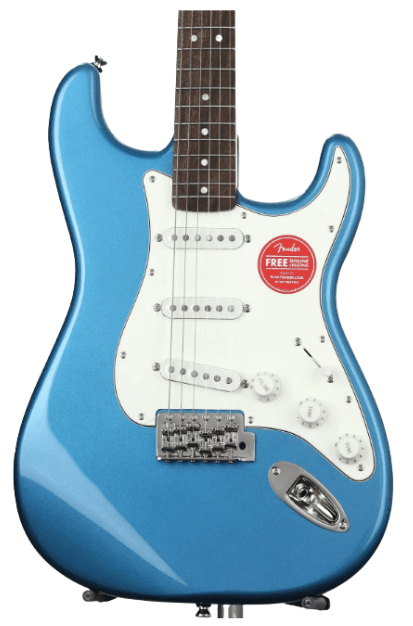
Squier Classic Vibe ‘60s Stratocaster
Squier’s flagship Stratocaster provides a real alternative to Fender branded models.
These Classic Vibe Strats are built to real Fender vintage specs, and offer an authentic experience with great tones, excellent playability, and the classic looks that have helped to maintain the Stratocaster’s perennial position as one of the world’s best sellers.
The Squier Classic Vibe ’60s Stratocaster sits (chronologically speaking) in the middle of Squier range of Classic Vibe Strats, with options from the ’50s and ’70s being available as well.
In a departure from the other models we tested for this roundup, the body on this ’60s Strat was made from nato, which believe it or not is a mahogany alternative. Fortunately it didn’t have much of an impact on weight, as the CV tipped the scales at a little under 8lb.
Our test model had the iconic candy-apple red finish, which we really loved. The paintwork has a deep luster and was very well applied.
The neck was maple, and came with a fantastic vintage tint that paired beautifully with the red paintwork. Around the front, the fretboard was Indian laurel. Our experiences with Indian laurel have been hit or miss, and unfortunately in this case it was a little dry and looked washed out, especially in comparison with the Jazzmaster and Jaguar.
As we often say, this is an easy fix with a few drops of lemon oil, but it’s something we hope would be done before the guitar leaves the factory. Fortunately, the rest of the neck was well-finished, particularly the frets.
Being a vintage-style guitar, it had the standard SSS setup and was equipped with high-quality alnico V pickups, similar to those found on the Fender Player Series Stratocasters. The alnico magnets weren’t quite as hot as those on the Affinity HSS Strat, making it noticeably warmer sounding in all positions. Despite the warmth, it still had tons of chime and quack, and all the Stratocaster character you could ever want.
Verdict: The Squier Classic Vibe ’60s Stratocaster was a pleasure to play. Had it not been for the dry fretboard, it could have been in contention for Editor’s Choice. Still, it delivered big on the classic Strat tone that players are looking for, and sounds remarkably similar to the much more expensive Player Strat, making it a great choice for working guitarists on a budget.
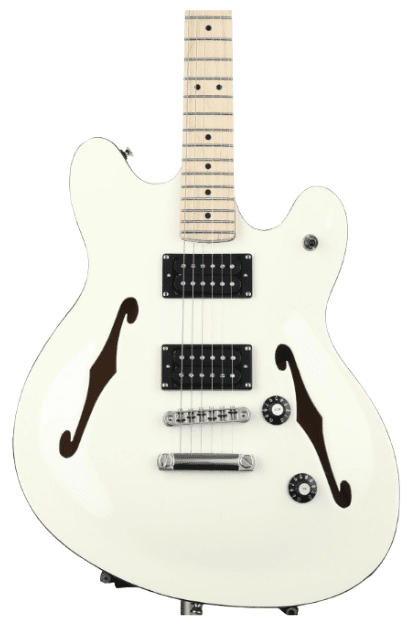
Squier Affinity Starcaster
A classic guitar brought bang up to date for today’s semi-hollow player.
If you thought that semi hollow body guitars were just for Gibson, Epiphone, and Gretsch, think again! This is an affordable interpretation of Fender’s ‘70s classic with authentic materials used throughout, and huge, fat tones from the humbucking pickups.
The Squier Affinity Starcaster (full review here) is one of the brand’s more unusual models, mainly down to the fact that Fender (and Squier by proxy) are almost exclusively known for their solid-body guitars. The Starcaster takes the classic semi-hollow design, and puts a unique twist on it, with its asymmetrical body and offset F holes, resulting in a handsome guitar that spans genres.
Our test Starcaster came to us in Olympic White, the finish quality was good, but, the wood around the F holes was a little rough. The body was made from all laminated maple, which is correct for a guitar of this type.
It had a C profile neck, which was easy-playing and very comfortable. It wasn’t the thinnest neck, but beginners and smaller players still shouldn’t have any issues reaching for chords or playing lead runs.
The neck was also maple, and like almost all other Fenders and Squiers, was bolt-on. This is only relevant because this style of guitar does typically come with a set neck, but we didn’t find that it affected performance in any major way.
We did like the narrow tall frets, which were easy playing and worked well with the standard 9.5” radius. Their edges were well-finished and the crowns were surprisingly smooth.
Being the Affinity model, it had standard Squier humbuckers, and we found that they were ideal for the task at hand. They were rich and warm, and completely killed any hum. The neck pickup was perfect for blues lead work, and the bridge position was fantastic with an overdriven amp, giving us chunky tones and the kind of ear-pleasing breakup that rock players live for.
Verdict: We really enjoyed playing with the Squier Affinity Starcaster. It’s a model that doesn’t usually get a lot of love, but anybody looking for an affordable, well-made semi-hollow guitar with good balanced tones shouldn’t sleep on them.
How to Choose The Right Guitar For You
There are so many Squier models available, many of which appear across multiple series, that it can be confusing to figure out which are best-suited to your needs. For that reason, we’ve created a Squier Buyer’s Guide to help you work through your decision.
Squier models are broken into different tiers, and these tiers make it quite easy to see which level of guitar you’re looking at.
Bullet
Bullet-series Squiers are the cheapest models in the entire lineup. They tend to use the least expensive components, and have thinner bodies than their Fender equivalents and some of the higher-spec’d Squier models. Guitars in the Bullet series include the Stratocaster, the Telecaster, and the Mustang.
Affinity
The Affinity series is the second tier, and offers some small upgrades over the Bullet Series. Affinity guitars are available in a wider range of finishes, and tend to have better-quality finishing on their necks. Affinity Stratocasters come with tremolo bridges, as opposed to the hardtails that accompany Bullet models. Guitars in the Affinity Series include the Stratocaster, the Telecaster, the Jazzmaster, and the Starcaster.
Contemporary
The Contemporary Series are made to a similar standard as the Classic Vibe, and are modeled after Fender’s incredibly popular Japanese-made Contemporary guitars from the ’80s. They are designed to push the limits of guitar innovation, and feature high-tech features unseen in any other Squier models. Guitars in the Contemporary Series include the Stratocaster, the Telecaster, the Jazzmaster, the Jaguar, and the Starcaster.
Paranormal
The Squier Paranormal Series, like the contemporary models, are made to the same standard as the Classic Vibe Series. They feature unique twists on classic Fender designs, including reverse offsets, oversize bodies, slanted pickups, mashups, and more. Guitars in the Paranormal Series include the Cabronita, the Super-Sonic, the Offset Telecaster, the Toronado, and the Cyclone.
Classic Vibe
Squier’s Classic Vibe models are their flagship guitars, and are modeled after iconic models from the ’50s, ’60s, and ’70s. They are made to a high standard with premium materials and components, and often find themselves compared with entry-level Fender models. Guitars in the Classic Vibe Series include the Stratocaster, the Telecaster, the Jazzmaster, the Jaguar, the Starcaster, the Esquire, and the Mustang.
Final Thoughts
If we’ve learned anything, it’s that there’s no shame in having a Squier logo on the headstock of your guitar. The guitars in this roundup have proven beyond a doubt that you can get an affordable, reliable, good-looking guitar with great tones, without having to buy a Fender.
To recap, our Top Pick was the Squier Affinity Stratocaster HSS, which offered versatile tones and looked amazing. The Squier Bullet Mustang was our Best Budget choice. It was tons of fun to play and is incredibly affordable. Finally, our Editor’s Choice was the Squier 40th-Anniversary Gold Edition Jazzmaster. It oozed cool and we’d have no qualms gigging or recording with it right out of the box.

